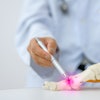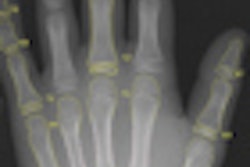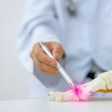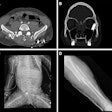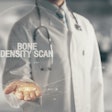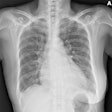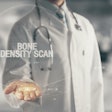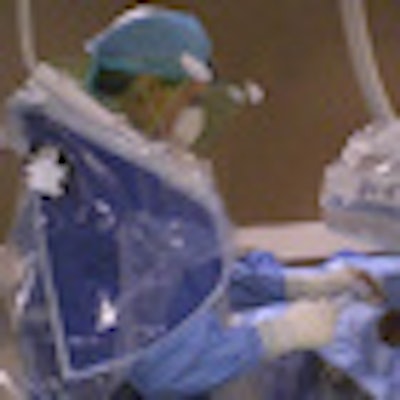
An interventional radiologist's quest to extend his injury-ridden career has led to a new option for radiation protection: the Zgrav suit. Early clinical trials suggest it could greatly affect how much radiation physicians absorb during fluoroscopically guided procedures.
Results from a phantom study indicate that Zero Gravity (Zgrav), a sophisticated suit of radiation-blocking armor, provides up to 78 times more radiation-stopping power than conventional lead aprons, eyeglasses, and shielding.
Moreover, the suit's design preserves user mobility while lifting its 47-lb weight off the interventionalist's shoulders, according to inventor Dr. Chet Rees, the interventional fellowship program director at Baylor University School of Medicine.
Rees created Zgrav as an alternative to the protective lead apron and other gear that he blamed for his chronically sore back. The heavy devices are widely considered a source of occupational injuries associated with the radiation protection required during fluoroscopy-guided procedures, he said.
Ionizing radiation from fluoroscopy guidance is also infamous for placing physicians at risk for cataracts and brain tumors, despite the use of lead aprons, glasses, thyroid shields, under-table shields, and other protective paraphernalia.
As the design for Zgrav came together, Rees learned that the apron weight and unresolved radiation protection issues could both be addressed.
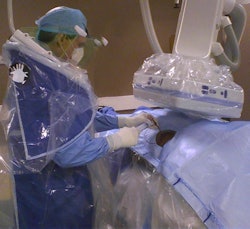 Recent studies have shown that the Zero Gravity (Zgrav) suit substantially reduces physician exposure to ionizing radiation during fluoroscopically guided procedures. Image courtesy of Dr. Chet Rees.
Recent studies have shown that the Zero Gravity (Zgrav) suit substantially reduces physician exposure to ionizing radiation during fluoroscopically guided procedures. Image courtesy of Dr. Chet Rees.
"When I realized it was going to feel weightless, I saw that we could load it up with protective gear that would get rid of the other shields," he said in an interview with AuntMinnie.com.
Two weight-bearing devices were developed to bear Zgrav's weight during procedures. One is based on a vertical support on wheels and horizontal slotted monorail, with a boom arm that connects the overhead support with the suit's collar; the other is based on a ceiling-mounted monorail configuration. Both are designed to maintain physician mobility while supporting the Zgrav suit's weight, Rees said.
CFI Medical Solutions makes and markets the product. U.S. Food and Drug Administration (FDA) 510(k) clearance for the device was secured in 2009, and it sells for about $50,000.
The prototype system tested in the phantom trial involved 1.25-mm lead (Pb) equivalency in front and 0.5 mm on the sides for protection from the user's collar to the midcalf. Flaps with 0.5 mm of Pb equivalency covered the upper arms. A clear, lead/acrylic face shield provided 0.5 mm of lead-equivalent protection from ear to ear, covering the thyroid, neck, eyes, and head.
In comparison, a lead apron typically offers no more than 0.5 mm of lead protection, Rees noted. Protection around the neck, head, and eyes is inconsistent, he said.
The phantom trial demonstrated the safety advantages of Zgrav and limitations of conventional shielding. Comparisons were performed using a single-plane angiography room with a mock patient consisting of a 26 cm-thick stack of Lucite to produce scattered radiation. A mock interventionalist was manufactured using a real skull on a vertical pole. Radiation exposure was measured with calibrated pocket dosimeters that provide real-time readouts sensitive to 1 µSv.
The measured doses for the standard lead apron, eyeglasses, and shielding were 16 to 78 times higher than doses at the same anatomic regions of the simulated physician enclosed in the Zgrav suit. The radiation dose for the apron was 78 times higher than for Zgrav at the left axilla, 45 times higher at the left eye, 57 times higher at the right eye, and 16 times higher at the gonad. All of the differences were statistically significant.
The study was published in the April 2011 issue of the Journal of Vascular and Interventional Radiology (Vol. 22:4, pp. 437-442).
The ability of Zgrav to block more radiation on the conventional apron and lead shielding was confirmed in a human study described a scientific poster at the 2011 Society of Interventional Radiology (SIR) annual meeting in March (Abstract 251). Results were drawn from 21 routine interventional radiology procedures performed by two radiologists and involving 175 minutes of fluoroscopy time.
According to the abstract, differences in the radiation exposure rates were most pronounced near the interventionalist's left eye. The 0.15 µSv/min radiation dose measured during Zgrav use was 92% lower than 1.81 µSv/min detected while the interventionalist used conventional shielding.
Radiation exposure with Zgrav was 88% lower (0.51 versus 4.39 µSv/min) than with conventional shielding at the tibia, and 78% lower (0.82 versus 3.7 µSv/min) at the upper arm or lower leg.
Radiation levels during Zgrav use were too low to measure with dosimetry badges attached to the chest, hip, midback, and neck.
Despite the large differences, the investigators concluded that it was not possible to equate them with increased lead equivalency from Zgrav because of measurement limitations with the dosimeters and the study's small sample size.
For Rees, such dose reductions are a bonus to achieving his original objective for developing the Zgrav. His back pain has disappeared, allowing him to continue to perform interventional radiology procedures. Other physicians have told Rees they couldn't practice without it.
"These are interventional radiologists with severe joint or disk problems," he said. "But most people will use it because of the increased protection."

